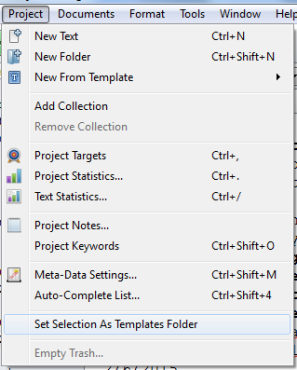Scrivener Tip: Making Document Templates
All writers face the blank screen and think about what they’re going to write. Too often we start and realize we didn’t format properly and stop, then get distracted by something else and we’ve lost our train of thought be the time we get back. Getting started can be daunting enough without spending time getting everything just right in your word processor.
Well, in Scrivener there’s a good way to beat back all that pre-writing distraction so you can sit down with your ideas and write. Who wants to lose their ideas to setting everything up? The answer is to make a template within your project.
What did you just read? That’s right a template within the project. You’ve heard of making a project template but how do you make a template within a project? Just follow these instructions.
1. Create a folder within the project and designate it as the Template folder by clicking on Project and Set Selection as Template Folder. Some project templates come with a template folder already designated so check you binder for one. Here’s what the template folder looks like: 
Here’s how to set a folder as the project template folder:
2. Once you’ve set the Template folder then create a document container under the folder. Configure all the settings you want with formatting in this container but leave it blank.
3. After you’ve completed configuring your document template it’s ready to use. Go to one of you folders in your project and when creating a new document container (text). Choose Project from the upper menu bar and then go to New from Template to get a fly-out menu. On this menu you will see all the document templates created for the project in which you are working.
4. You can also create such a document template from the cork-board view of a folder. Right click for a context menu, go to Add for a fly-out menu. Slide your cursor to New from Template to reveal the fly-out menu or your document templates. You can also do the same from the Binder by right clicking on a folder for a context menu and using the same directions.
5. At this point, you can name the new container and start writing without a need to change settings. Create as many of these document templates as necessary for your project.
One again, here’s a simple way to use Scrivener to make writing easier than ever.
 Do you get distracted by repeated changes to format settings? What would you change to start writing faster on any given project? Please share your thoughts and ideas in the comments section. I’d also love to connect with you over social media so check my Contact page for that information. See the News page for announcements and remember to sign-up to receive news and posts by email. I’ve added a new sign-up tab on my FaceBook page to simplify the process. New followers can download The Black Bag via free coupon today! Also, the cover of my book, The Bow of Destiny, was revealed recently so take a look.
Do you get distracted by repeated changes to format settings? What would you change to start writing faster on any given project? Please share your thoughts and ideas in the comments section. I’d also love to connect with you over social media so check my Contact page for that information. See the News page for announcements and remember to sign-up to receive news and posts by email. I’ve added a new sign-up tab on my FaceBook page to simplify the process. New followers can download The Black Bag via free coupon today! Also, the cover of my book, The Bow of Destiny, was revealed recently so take a look.
Follow Blog via Email
Enter your email address to follow this blog and receive notifications of new posts by email.
Filed under: Blogging, Cover Reveal, Creativity, Editing, Indie Publishing, Planning, Scrivener, Self-publishing, Tech Tips, Templates, Tips, Twitter, Writing Tagged: blogging, Coverart, creativity, Editing, Facebook, Formatting, Indie Publishing, P. H. Solomon, Planning, Scrivener, Self-publishing, Social Media, The Black Bag, The Bow of Destiny, Twitter, writing








